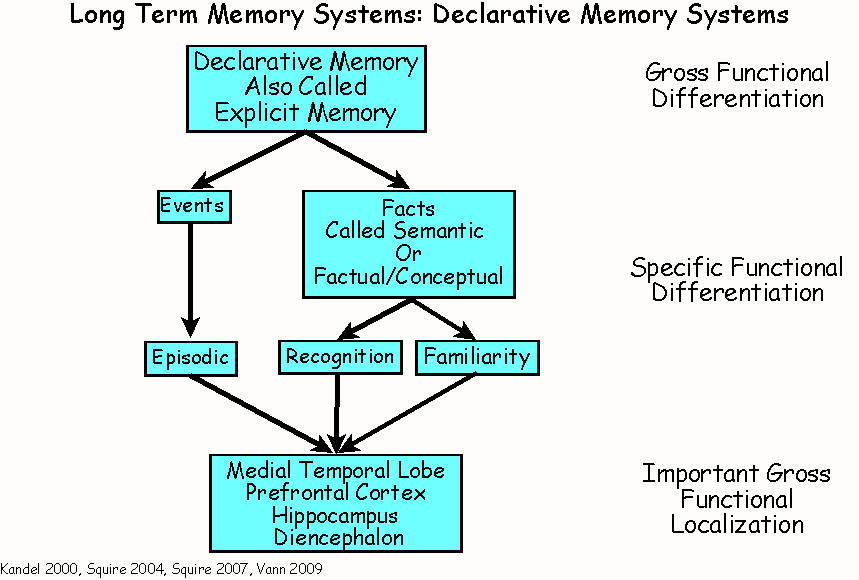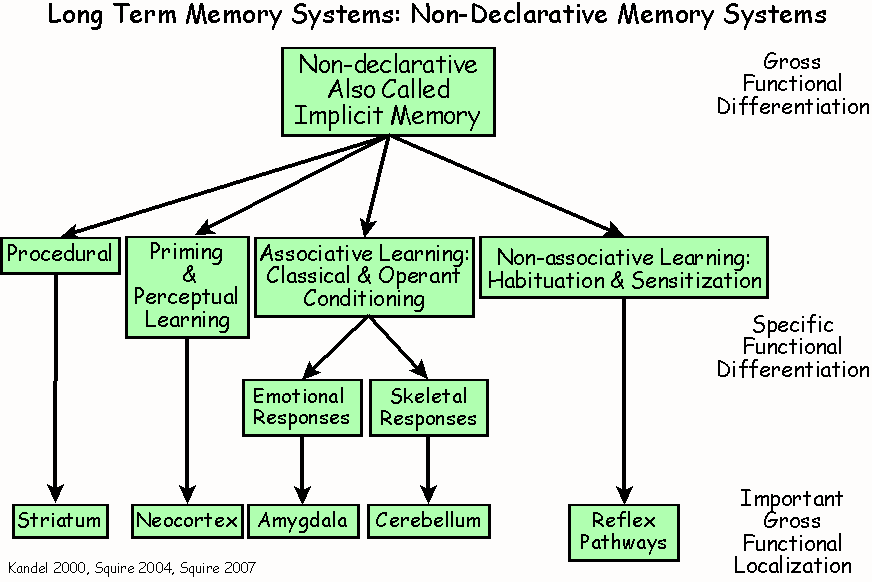|
Studying Explanation:
There
is no one-size-fits-all set of practices for how best to study.
However, knowing just a little bit about how your brain works will help
you to maximize your study efforts. Many factors affect memory
including mood, environment--even time of day. I'll briefly discuss
the three important elements of long-term learning and memory for facts and relate
them to the questions above. I will then discuss the distinction
between two different kinds of memory--what psychologists call
"declarative memory" and "procedural memory".
Remembering facts, Ideas, Concepts
Memory can be usefully divided into (1)
short-term (also called immediate or working memory) and (2)
long term memory. To learn information you must first get that
information into short-term memory. In order to retain that
information you must transfer (consolidate) that information into
long-term memory. Many discussions of memory end here.
Unfortunately, this is a horrible omission!! What these discussions
leave out is that (3) your brain also
forgets!! This shouldn't surprise anyone. We've all
experienced situations where we learned something, only to be unable to
recall it latter. For instance, can you remember all your teacher's
names from junior high and elementary school? In order to study
efficiently, you need to address all three elements of memory. So,
I'll discuss each in turn
Short-term
memory
If information doesn't get into short-term memory, then you're unlikely to
remember it at all. Three factors can improve your ability to get
information into short-term memory, and to get the right information into
short-term memory; attention, motivation, and focus. You can think of
attention as a spotlight that allows you to see wherever it shines.
If you don't focus your attention on information, it's unlikely to
enter into short-term memory, just like it's unlikely you'll see anything
when you walk into a dark room unless you shine your flashlight on it.
So, just coming to class doesn't mean that you'll learn
something--especially if you are surfing the web or talking with friends,
etc.. The best way to focus attention is through motivation.
If you come to class to learn the material, even better, if you come to
class with specific learning objectives, then you help yourself to focus
attention on the information you need to learn. For this reason, I
emphasize taking an active role in studying by (a)
preparing yourself to learn, (b) actively
looking for information, and (c) rehearsing
and recording that information in ways that require you to attend to its
content. Finally, the relatively puny size of your working memory
proves one of its most important features. As we will see
repeatedly during the term, your working memory is small. You can
easily exceed its capacity by exceeding the amount of information it can
contain, the complexity of that information, and/or by trying to do too
much with that information (processing). Therefore, you should try
to develop the habit of focusing on a manageable amount of
information/complexity/processing. For example, when you study
don't have the television in the background. When you are
processing information, especially when learning a process, try to break
the process down into steps that your working memory can handle.
For example, when you are writing you should try to separate tasks like
checking grammar and revising content.
Long-term
memory
In order for you to store information in long-term memory your brain must
literally move it from one part of your brain another part of your brain
and/or create long-term structural changes in your brain. Not
surprisingly, this process takes time. Thus, while some memories
seem to form rather quickly, most long-term memories must be created by effort and
time. This process is often called memory consolidation. Three
important results can help you to better facilitate memory consolidation.
Your brain works hard to consolidate your memories while you sleep.
So, (a) it is best to study before going to
bed or before doing something that isn't very intellectually demanding.
(b) Scientists have long known that
repetition helps your brain to consolidate information into long-term
memory, so studying often is a good idea. Repetition, however,
is the blunt instrument of learning and memory--mere repetition helps, but
the effectiveness of simply repeating information is not that dramatic for
each repetition, and its effectiveness decreases the more you do it.
(c) Consolidation
is greatly facilitated by actively drawing connections between ideas,
integrating the information with your own experiences through rephrasing
it in your own words and your own examples, rehearsing information through
different modalities, (visually, reading, writing, speaking, etc..).
A particularly good way to rehearse information is by first trying
to recall or recreate the information, then comparing your results to your
notes or the course materials. You can summarize these points by the
keywords: generate, associate, integrate, and switch-up.
Forgetting
There are many theories about forgetting and how/why it occurs.
However, for our purposes we can note features that increase your ability
to recall information for long periods of time.
(a)
Practice: It turns out that people who learn and use their memory more
often start to learn faster and better than people who do not exercise
these capacities.
(b) Integrated or meaningful storage: If you attempt to learn
information by integrating it with what you already know or by making
associations between ideas, this facilitates better recall for longer
periods.
(c) Retrieval cues: Some theories suggest that failing to recall
information is often a failure to retrieve the information using the best
or strongest cues or prompts. For instance, you might not be very
good at telling me if a person was in your sixth grade class when I ask
you by listing names, but your performance might increase if I show you
pictures instead. One strategy to help with retrieval cues is to
structure your reviews by trying to retrieve the information and then
going back and working on those connections and ideas for which you are
weakest in your recall. Another strategy is to associate information
with a specific cue to facilitate recall. For example, diagrams or
Mnemonics (creating poems or acronyms to summarize key points).
(d) Finally, revisiting the material in spaced intervals over a longer
period of time facilities recall and length of recall.
Here is a learning and memory summary chart:
|
Learning and Memory Summary Chart |
|
 |
Two Types of Memory
We normally think of our memory as a single system. However, human
memory is divided into two major kinds of memory. Each kind of
memory has a number of specialized systems. We will focus on the
main distinction between memory for facts and events, called declarative
memory, and memory for skills and abilities, called procedural memory.
The discussion above focused upon remembering fact, ideas, concepts, and
events. The memory systems that facilitate the learning and memory
for such information are called declarative memory systems.
Declarative memory systems share a common functional characterization
and a significantly overlapping neural substrate. At the functional
level, researchers consider declarative memory systems to encode factual
information (i.e., people, places, things, and times) as well as the
significance of such information by explicitly representing it. Though
not necessarily encoded by sentences in the brain, normal subjects can
express information stored in declarative memory through linguistic
and/or graphic mediums (i.e., through words and pictures) with
sufficient precision to warrant its evaluation for veridicality--most
often truth-functionality. Declarative memory systems encode
information from many cognitive systems in a manner which is both
associative and versatile in its application, and in the elicitation of
stored memories. For example, your semantic knowledge about coffee can
be elicited by the sight, smell, taste, or abstract thought of coffee.
Likewise, you can use your knowledge about coffee to make decisions,
solve problems, or explain why Wallis has a headache (caffeine
withdrawal). Encoding of declarative memories depends upon
conscious attention, and occurs relatively quickly in many cases. Recall
also requires conscious effort.
In contrast, when one learns an
association, procedure, skill, or process one uses a non-declarative memory system.
Non-declarative memory is neither explicitly represented nor easily
accessible to consciousness. Moreover, encoding in non-declarative
memory involves modifications to specialized performance
systems--i.e., modifying processes--and is thus is relatively
modal-specific (specific to the memory system and generally specific to
the context). For instance, the encoding of many non-declarative
memories involves a gradual encoding of commonalities or patterns in
events or in a series of events. For instance, professional basketball
players have been encoding commonalities in how to make free-throws
since they were kids. Recall occurs in non-declarative memory by
recreating the process or performance. For example, procedural memory
encodes information about how to ride a bike by associatively encoding
motor sequences. When you use your procedural memory to ride a bike, you
donít recall information. Rather, the associated motor sequences are
reactivated during the performance of bike riding (recall). Motor
sequences are not the only type of processes that one learns using
non-declarative memory. For instance, problem solving, writing,
and similar processes also involve non-declarative memory. The
best way to learn an association, procedure, skill, or process is
through making the association, performing the procedure, exercising the
skill, or going through the process. Specifically, trying to
perform the task without help or feedback followed by getting feedback
on your performance, followed by trying again using that feedback works
best for learning associations, procedures, skills, or processes.
In other words, do problems! Of equal or greater importance,
expend serious time and effort trying to solve the problem BEFORE
checking the answer or asking me, when you check the answer or get
feedback make sure you understand where you went wrong, then do at
least one more problem immediately afterward.
|
The Memory Systems of the Brain |
|
 |
 |
|


